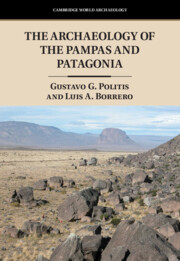Book contents
- The Archaeology of the Pampas and Patagonia
- Cambridge World Archaeology
- The Archaeology of the Pampas and Patagonia
- Copyright page
- Dedication
- Contents
- Acknowledgments
- Chapter 1 Introduction
- Chapter 2 Historical Background
- Chapter 3 Resources: Prey, Plants, and Stones
- Chapter 4 The Early Peopling: The Late Pleistocene to Early Holocene
- Chapter 5 The Middle Holocene (~ 8200–4200 cal BP; ~ 7500–3800 BP)
- Chapter 6 The Late Holocene Diversification (~ 4200 cal BP to ~ 400 cal BP; ~ 3800 BP to ~ 400 BP)
- Chapter 7 Final Remarks
- Select Bibliography
- Index
Chapter 5 - The Middle Holocene (~ 8200–4200 cal BP; ~ 7500–3800 BP)
Published online by Cambridge University Press: 14 February 2024
- The Archaeology of the Pampas and Patagonia
- Cambridge World Archaeology
- The Archaeology of the Pampas and Patagonia
- Copyright page
- Dedication
- Contents
- Acknowledgments
- Chapter 1 Introduction
- Chapter 2 Historical Background
- Chapter 3 Resources: Prey, Plants, and Stones
- Chapter 4 The Early Peopling: The Late Pleistocene to Early Holocene
- Chapter 5 The Middle Holocene (~ 8200–4200 cal BP; ~ 7500–3800 BP)
- Chapter 6 The Late Holocene Diversification (~ 4200 cal BP to ~ 400 cal BP; ~ 3800 BP to ~ 400 BP)
- Chapter 7 Final Remarks
- Select Bibliography
- Index
Summary
The Middle Holocene was a time of change in both the Pampas and Patagonia. In some way, these changes were the prelude to the demographic expansion, regional diversification, economic intensification, and social complexity that characterized the following period, the Late Holocene. During the Middle Holocene times, archaeological evidence in the Pampas was scarce until a decade ago or so, but recent research increased information significantly (e.g., Ávila 2011; Ávila et al. 2011; Bonomo et al. 2013; Donadei Corada 2020; Gutiérrez et al. 2010; Mazzanti et al. 2015; Messineo et al. 2019a, b, c; Politis et al. 2012; Scheifler 2019). This period is characterized by global warming, known as the Hypsitermal or Holocene Thermal Maximum (Renssen et al. 2012). As a result, in the Pampas, the sea level raised above the current level at around 7000 BP. However, there is no agreement about the magnitude of this raising (between 2.2 to 6 masl depending on the author) and the chronology of the maximum ingression (see revisions in Aguirre and Whatley 1995; Melo et al. 2003). For Isla and Espinosa (1995), it began at the onset of the Holocene, reaching its maximum height (around 2 masl) around 6500–6000 BP. This resulted in the coast having sometimes a transgressive position, such as in the east of the Salado Depression and the Paraná Delta (Cavallotto et al. 2004, 2005; Iriondo and Kröhling 2008), while in other cases, it was very close to the present according to the variations of the littoral morphology.
- Type
- Chapter
- Information
- The Archaeology of the Pampas and Patagonia , pp. 157 - 193Publisher: Cambridge University PressPrint publication year: 2024



